When I asked ANCAP Chief Technical Officer Mark Terrell about the fact that P-Platers tend to end up driving the oldest and cheapest cars in the family because they are most likely going to get dented, his advice was that putting our least experienced drivers in the cheap, old cars is not the best thing to do.
Safety should be the top priority when choosing the best cars for the P-Plater in your family. Mark Terrell said to look for the car with the most recent ANCAP five-star rating and date stamp within your budget and then have a look at the included safety assist features most relevant to your needs.
Here, we have put a list of reviews together for you to help make that search easier…
Subaru Forester

The Subaru Forester is the ultimate P-Plater car, great offroad with great safety and really practical to get your mates in the back and surfboards on the roof! We have taken ours all around Australia and up Cape York too so I am happy to vouch for their ability.
Brand new, they range from $31K – $49K but you will pick up a bargain for a used pre-2019 model now.
How safe is the Subaru Forester?
The Subaru Forester scored a five-star ANCAP safety rating in 2013, getting a total of 35.64 out of 37 overall. For the frontal offset test, it got 14.64 out of 16 and 16/16 for the side impact test. It got 2/2 for the pole test and in the pedestrian protection test, it was rated acceptable.
Seven airbags come as standard; there is a driver's knee airbag as well as dual frontal airbags and front side airbags and side curtain airbags for the front and the rear side passengers.
As standard, the Subaru Forester comes with all-wheel drive (AWD), anti-lock brakes (ABS), electronic stability control (ESC), electronic brake force distribution (EBD), along with brake assist and traction control system (TCS) and hill start assist.
Top spec models come with the vision assist package consisting of an adaptive driving beam (ADB), blind spot monitor (BSM), lane keep assist (LKA), rear cross traffic alert (RCTA), side view monitor (SVM). As well as the SI-Drive EyeSight driver assist package which includes adaptive cruise control (ACC), brake light recognition, lane departure warning (LDW), lane departure warning (LDW), lead vehicle start alert, pre-collision braking system, pre-collision brake assist and pre-collision throttle management.
Mazda3
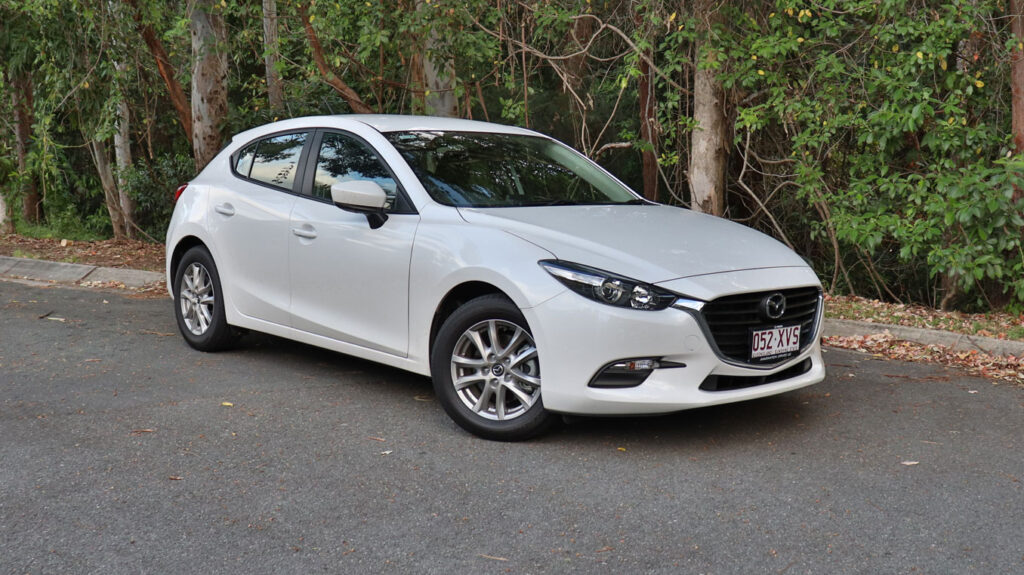
The Mazda3 is a great little hatch to drive and now the new model is out, the pre-2019 models will be very affordable. With child seats probably not yet being a consideration, a P-Plater will have enough space for a few mates on board.
New they range from $21K – $36K.
How safe is the Mazda3?
The Mazda3 scored a five-star ANCAP safety rating in 2016, getting a total of 36.40 out of 37 overall. For the frontal offset test, it got 15.40 out of 16 and 16/16 for the side impact test. It got 2/2 for the pole test and in the pedestrian protection test, it was rated acceptable.
Six airbags come as standard; there are dual frontal airbags as well as side head and chest airbags for the front and the rear passengers as well.
As standard, the Mazda3 comes with anti-lock brakes (ABS), autonomous emergency braking (AEB), electronic brake force distribution (EBD), electronic stability control (ESC), along with emergency brake assist (EBA) and emergency stop signal (ESS), hill launch assist and pre-crash systems.
Mazda CX-3

The Mazda CX-3 is a fun, nippy and good looking little SUV. It's nimble around town, easy to manoeuvre in tight parking spaces and good out on the open roads too. It's been around for several years now and very popular so heaps are available used.
New they range from $23K – $38K.
How safe is the Mazda CX-3?
The Mazda CX-3 was given a five-star ANCAP safety rating in 2015. In testing, it scored 36.44 out of 37. For the frontal offset test, it scored 15.44 out of 16 and full marks for side impact and pole crash tests.
The Mazda CX-3 has six airbags as standard. Both front passengers have front and side airbags and curtain head airbags extend to the rear passengers as well.
As standard, the Mazda CX-3 comes with seatbelt pre-tensioners in the front and rear outboard seats, anti-lock brakes (ABS), electronic brake force distribution (EBD), electronic stability control (ESC), emergency brake assist (EBA) and emergency stop signal (ESS) and hill launch assist.
Also optional on base variants but maybe standard on higher variants is rear cross-traffic alert, autonomous emergency braking (AEB), blind spot monitoring (BSM).
Not available on base variant but standard or optional on higher variants is reversing collision avoidance, lane departure warning (LDW), daytime running lights (DRL), automatic headlights, automatic high beam.
Toyota Corolla

The Toyota Corolla Hybrid uses both an electric motor and traditional engine, it is silent to start and pull off which could be offputting if you learnt to drive in a traditional engine car. But being a hybrid, it may help with saving money on fuel in those early years of driving. The petrol engine didn't kick in until I was doing about 40km/h or if I was accelerating quickly at lower speeds. So you could do a lot of pootling around town or to mates without using much fuel at all. This is still quite a new model on the market and packed with safety technology, but the previous model was also a good little car.
New they range from $25K – $31K.
How safe is the Toyota Corolla Hybrid?
The Toyota Corolla Hybrid was given a five-star ANCAP safety rating in 2018. It scored 96% for adult occupancy protection, 83% for child occupant protection (this will tell us about protection for rear passengers), 86% for vulnerable road user protection and 76% for safety assist.
The Toyota Corolla has seven airbags as standard; there is a driver’s knee airbag as well as dual frontal airbags and front side chest airbags and side head-protecting curtain airbags for the front and the rear side passengers.
All models of the Toyota Corolla come with lane departure warning (LDW), and lane keep assist (LKA), electronic brake-force distribution (EBD), anti-lock braking system (ABS), electronic stability control (ESC), and traction control, hill-start assist, active cornering assist, engine immobiliser, pre-collision safety system with pedestrian and cyclist detection, road sign (speed) assist, all-speed active cruise control (ACC) and automatic high beam.
Kia Cerato
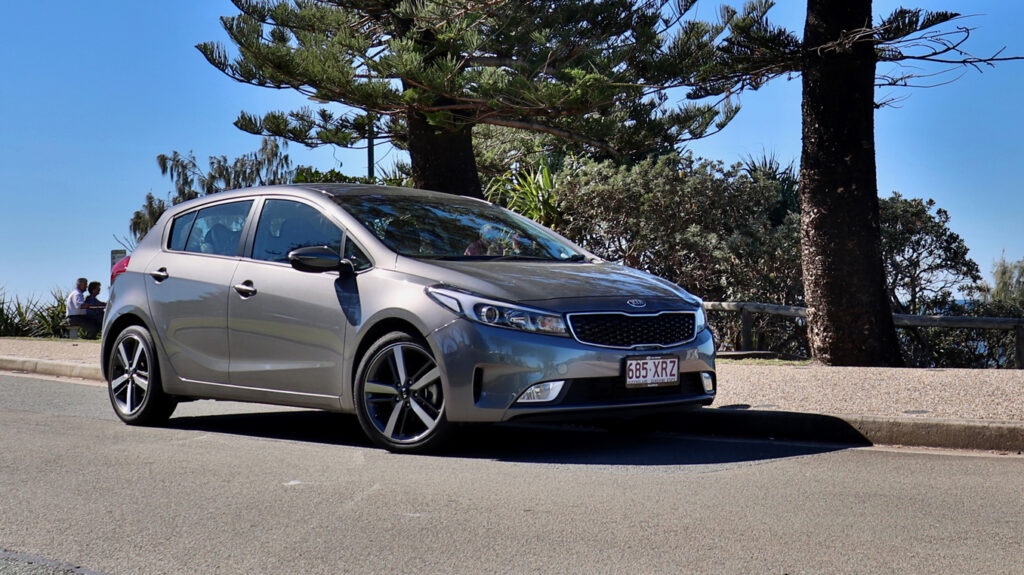
The Kia Cerato was awarded 2016 Australia's Best Small Car under $35,000 and is a popular little runabout! Legroom and interior space is very good for a small hatch so if you have a tall new driver this is a good choice! This model has recently been replaced, which will mean there are plenty of bargains about as it was very good value as a new car.
New they range from $20K – $33K.
How safe is the Kia Cerato?
The Kia Cerato scored a five-star ANCAP safety rating in 2014. It was awarded a total score of 35.51 out of 37. For the frontal offset test, it scored 14.51 out of 16 and for the side impact test it got 16/16. Scoring 2/2 for pole test and pedestrian detection was rated acceptable.
The Cerato Sport has six airbags as standard. Driver and front passenger frontal airbags, front side airbags and curtain airbags for front and rear passengers.
The Kia Cerato Sport comes with anti-lock braking system (ABS) with emergency brake distribution (EBD) and brake assist, electronic stability control (ESC) with traction control, vehicle stability management (VSM), hill-start assist control (HAC), emergency stop signal (ESS) and speed sensing auto door lock and impact sensing auto door unlocking.
Kia Rio
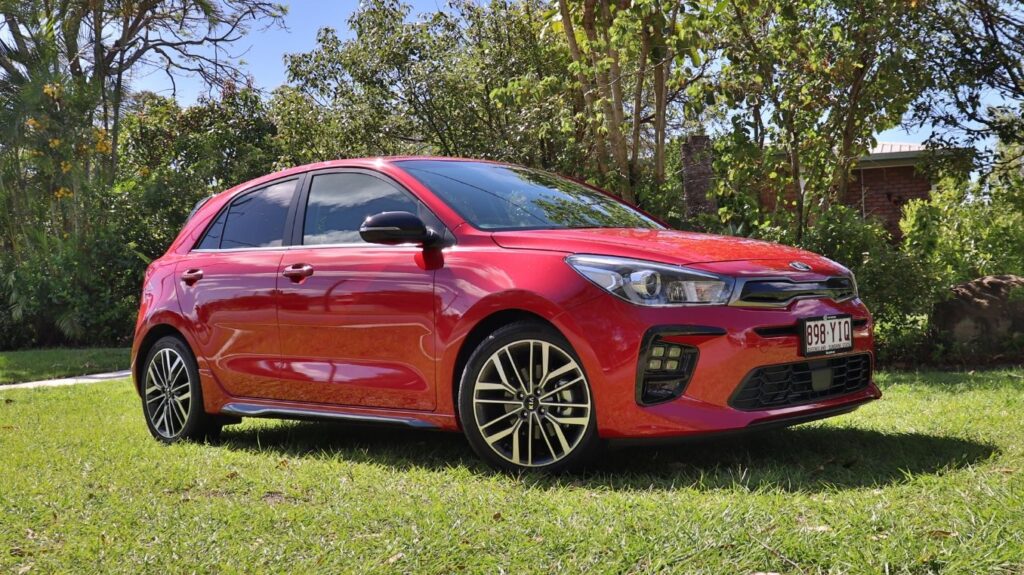
The Kia Rio GT Line is SUCH a great car for the price, it is so much fun to drive and full of great comfort and safety features for an entry-level car.
New they range from $17K – $22K.
How safe is the Kia Rio GT Line?
The Kia Rio has a five-star ANCAP safety rating in 2017.
In testing, it scored 14.52 out of 16 for the frontal offset test, full points for side impact and pole testing, pedestrian protection was rated acceptable and it gained an overall score of 35.52 out of 37.
The Kia Rio GT Line has six airbags as standard. Both front passengers get front and side chest airbags and side head curtain airbags extend to the rear passengers.
As standard, the Kia Rio GT Line comes with seatbelt pretensioners in the front seats, anti-lock brakes (ABS), electronic brake force distribution (EBD), electronic stability control (ESC), emergency brake assist (EBA), daytime running lights (DRL), hill launch assist, autonomous emergency braking (AEB), forward collision warning (FCW), lane keep assist (LKA), driver attention alert (DAA), automatic headlights. Speed sensing auto door locking and impact sensing auto door unlocking.
Hyundai i30
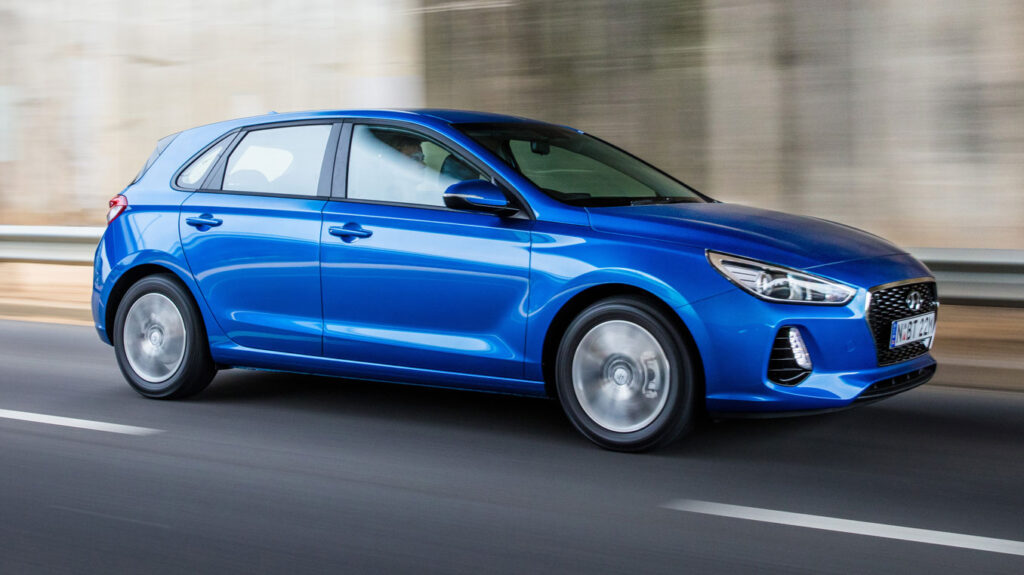
The Hyundai i30 is a favourite of mine! For the price, I can rarely recommend another stylish and sporty little hatch. Don’t go past the i30 without giving it serious consideration, it is jammed full of safety features, sat-nav and a great media screen. A fantastic first car to drive for a really affordable price!
We tested both ends of the price range and the Active being the base model had everything you could need and the ridiculously fast N that many P-Platers might desire but is perhaps a bit too much for an inexperienced driver!
New, they range from $20K – $40K.
How safe is the Hyundai i30?
The Hyundai i30 has been given a five-star ANCAP safety rating, in 2017 onwards.
In testing, it scored 14.01 out of 16 for the frontal offset test, full points for side impact and pole testing, pedestrian protection was rated acceptable and whiplash protection was rated good. It gained an overall score of 35.01 out of 37.
The Hyundai i30 Active comes with a lot of standard safety gear including seven airbags. This includes front and side airbags for both front passengers, a driver's knee airbag and full-length curtain airbags for front and rear passengers.
It also has electronic stability control (ESC), traction control, anti-lock brakes with electronic brake-force distribution (EBD), brake assist and hazard light activation when emergency braking, tyre pressure monitoring (TPMS), hill-start assist and an anti-theft alarm,
At the time we drove the i30, all manual gearbox versions and the cheapest Active model did not have autonomous emergency braking but Hyundai promised it would become a standard feature around Easter 2018.
The Premium models have Hyundai Smart Sense safety packages which feature adaptive cruise control (ACC), lane-change assist (LCA), lane-keep assist (LKA), driver attention alert (DAA), blind spot detection (BSD) with rear cross-traffic alert, autonomous emergency braking (AEB) and forward collision warning (FCW).
Suzuki Vitara
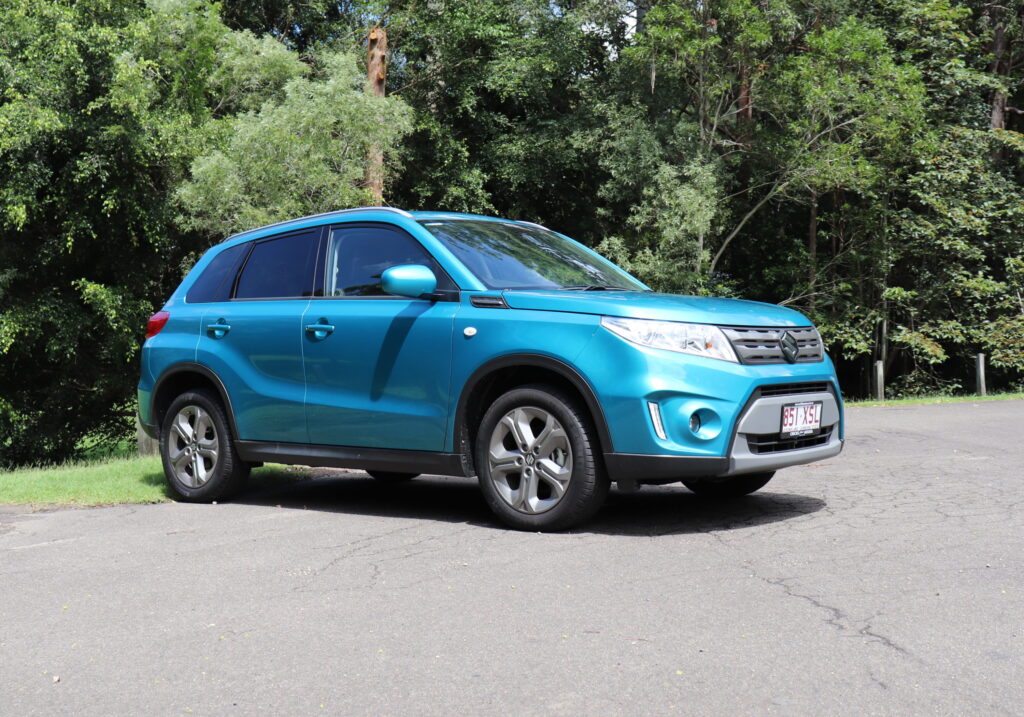
The Suzuki Vitara is a good looking car, in a great colour, and I was won over by its retro, boxy styling!
is a great little SUV to drive, modern enough with eye-catching colour choices inside and out AND has enough space for a few mates on board.
New they range from $30K – $35K.
How safe is the Suzuki Vitara?
The Suzuki Vitara scored a five-star ANCAP safety rating in 2015.
It got an overall score of 35.79 out of 37. Getting 14.79 out of 16 for frontal offset test, 16 out of 16 for side impact and pedestrian protection was rated good.
The Vitara comes with seven airbags as standard, dual frontal, front side and driver knee airbag and (head protecting) curtain airbags for front and rear side passengers.
As standard, the base model Vitara comes with antilock brakes (ABS), electronic brake distribution (EBD) and electronic stability control (ESC) and LED daytime running lights, speed assistance – manual speed limiter and alarm, reversing collision avoidance and emergency brake assist (EBA)
Available on higher spec versions are hill launch assist (auto only), lane support system (LSS), blind spot monitoring (BSM), automatic high beam, autonomous emergency braking (AEB) and adaptive cruise control (ACC).
Volkswagen Polo

The VW Polo is a great fun first car! It has retained that sense of fun and freedom which is exactly want you want in your first set of wheels! The Polo is very nippy and corners really well.
They are extremely good value, new they range from $18K – $23K.
How safe is the Volkswagen Polo?
The VW Polo scored a five-star ANCAP safety rating in 2017, that is rated for vehicles from 2018 onwards, scoring 96% for adult occupancy and 85% for child occupancy protection, 76% for pedestrian protection and 59% for safety assist.
In the adult occupancy testing the scores break down to, 7.56 out of 8 for the frontal offset test, 7.80 out of 8 for full-width frontal crash test, 8/8 in the side impact test and the oblique pole test and 2.36 out of 3 for whiplash protection and 3 out of 3 for AEB (city).
In the child occupancy testing, it scores 14.98 out of 16 in the dynamic test (front), 8/8 for the dynamic test (side), 12/12 for the restraint installation and 7 out of 13 for the onboard safety features.
It comes with six airbags as standard. Dual frontal and chest airbags for both front passengers, curtain head airbags for front and rear outboard passengers.
The VW Polo also comes with seatbelt pre-tensioners in the front and rear outer positions, anti-lock braking system (ABS), autonomous emergency braking (AEB) city and interurban, electronic brakeforce distribution (EBD), electronic stability control (ESC), emergency brake assist (EBA), an emergency stop signal (ESS), fatigue reminder, forward collision warning (FCW), daytime running lights (DRL), hill launch assist, secondary collision brake assist and tyre pressure monitoring system (TPMS).
Adaptive cruise control (ACC), automatic headlights, automatic high beam, blind-spot monitoring (BSM) and lane keep assist (LKA) are available on different spec models.
Subaru XV

The Subaru XV is a great fun first car! It has a spacious cabin for tall teenagers, it has all-wheel-drive which is good for safety as it helps make it more stable in the wet and on dirt roads. The previous model looks almost identical, so P-Platers won't feel like they're missing out on the newer design while saving a heap of money!
New they range from $28K – $36K.
How safe is the Subaru XV?
The Subaru XV is fitted with seven airbags as standard. Front and side airbags for both front passengers and a knee airbag for the driver, as well as curtain head airbags offering protection for the heads of the front and rear side passengers in the event of a side impact.
The Subaru XV has a five-star ANCAP safety rating, scoring 35.8 out of 37. Scoring 14.80 out of 16 in the frontal offset test. Gaining maximum points for both the side impact test, 16 out of 16, and for the pole test, 2 out of 2. Whiplash and pedestrian protection were both rated ‘good’ as well. The XV scored 3 out of 3 for seatbelt reminders as it is fitted with alerts for both front and back passengers seatbelts.
The safety features vary throughout the XV range. We drove the lowest spec model the XV 2.0i which comes with the most minimal amount: electronic stability control (ESC), hill holder, rear vision camera, anti-lock brakes, electronic brake distribution and traction control.
As you move up the range to the 2.0iL the safety features increase, adding lane departure warning (LDW), lane keep assist (LKA), autonomous emergency braking (AEB) for low and high speeds and front collision warning (FCW).
The top spec 2.0iS model comes with the full package adding blind spot sensors, brake assist, rear collision warning, rear cross traffic warning when reversing and lane change assist.
Mitsubishi ASX

The Mitsubishi ASX is an affordable SUV for a first car, interior space is good for a car of this size so mates will fit in the back and it's practical. It's been on the market for ages and has always been super popular, so there will be a lot of bargains about.
They are extremely good value, new they range from $25K – $38K.
How safe is the Mitsubishi ASX?
The Mitsubishi ASX has seven SRS airbags as standard. In the front, the driver and passenger have side and frontal airbags and one for the driver's knee. As well as curtain airbags the length of the car for the front and back side passengers.
The Mitsubishi ASX was given a five-star ANCAP safety rating in 2014. Getting a total of 34.13 out of 37 overall. For the frontal offset test 14.13/16 and 16/16 for the side impact test. Scoring 2/2 for the pole test.
The ASX does not have AEB which is standard in most modern cars. The Exceed model I tested does have forward collision warning (FCW), lane departure warning (LDW), blind spot warning (BSW), lane change assist (LCA), rear cross traffic alert (RCTA), automatic high beam (AHB), emergency stop signal function (ESS), emergency brake assist system (EBA), hill start assist (HSA), active stability control (ASC), active traction control (ATC), anti-lock braking system (ABS), electronic brakeforce distribution (EBD) and brake override system (BOS).
Although forward collision warning (FCW), lane departure warning (LDW), blind spot warning (BSW), lane change assist (LCA), rear cross traffic alert (RCTA), automatic high beam (AHB), are not standard on all variants.






Be the first to comment